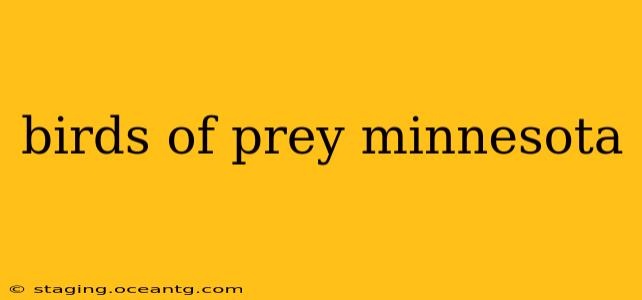Minnesota, with its diverse habitats ranging from boreal forests to prairie grasslands and expansive wetlands, supports a remarkable variety of birds of prey. These magnificent raptors, known for their sharp eyesight, powerful talons, and exceptional hunting skills, play a crucial role in maintaining the state's delicate ecosystem. This guide explores the fascinating world of Minnesota's birds of prey, covering their identification, habitats, and conservation status.
What Birds of Prey Can Be Found in Minnesota?
Minnesota is home to a variety of diurnal (day-active) and nocturnal (night-active) birds of prey. Diurnal raptors commonly seen include:
- Red-tailed Hawk: Perhaps the most common and easily recognized bird of prey in Minnesota, the red-tailed hawk is a large, powerful bird with a distinctive reddish tail. They are adaptable and found in various habitats.
- Northern Harrier: This slender hawk is a master of low-level flight, often hovering over grasslands and marshes in search of prey. Their long tails and distinctive white rump patches help with identification.
- Sharp-shinned Hawk: A smaller, more agile hawk, the sharp-shinned hawk is known for its quick movements and preference for hunting smaller birds.
- Cooper's Hawk: Slightly larger than the sharp-shinned hawk, the Cooper's hawk is a formidable predator of birds and sometimes small mammals.
- Bald Eagle: A majestic symbol of the United States, the bald eagle is a magnificent sight to behold. While once endangered, their populations have rebounded significantly in Minnesota.
- American Kestrel: The smallest falcon in North America, the American kestrel is a colorful bird with a distinctive rufous back and tail.
- Rough-legged Hawk: This hawk is a winter visitor to Minnesota, often seen soaring over open fields and grasslands. Their feathered legs are a key identifying feature.
- Osprey: A specialized fish-eating bird of prey, the osprey is often found near lakes and rivers. They build large nests typically on tall structures near water.
Nocturnal birds of prey in Minnesota include:
- Great Horned Owl: A large, powerful owl with prominent ear tufts, the great horned owl is a widespread predator found in various habitats.
- Snowy Owl: This stunning white owl is a winter visitor to Minnesota, often seen in open fields and prairies.
- Long-eared Owl: A smaller owl with long ear tufts, the long-eared owl prefers wooded areas and is often well-camouflaged.
- Short-eared Owl: This owl is often found in grasslands and marshes and is less easily spotted due to shorter ear tufts.
- Barn Owl: A distinctive owl with a heart-shaped face, the barn owl is found in more open areas with suitable nesting sites.
What are the Habitats of Birds of Prey in Minnesota?
The habitats of Minnesota's birds of prey vary greatly depending on the species. Some prefer open areas like grasslands and prairies (e.g., Northern Harrier, Short-eared Owl, Rough-legged Hawk), while others are found in wooded areas (e.g., Cooper's Hawk, Long-eared Owl). Bald eagles and ospreys require access to water bodies, while others like red-tailed hawks are remarkably adaptable.
How Can I Identify Different Birds of Prey in Minnesota?
Identifying birds of prey requires attention to detail, including size, shape, plumage, flight patterns, and habitat. Field guides and online resources with photos and descriptions are invaluable tools. Learning to distinguish wing shapes, tail patterns, and overall body proportions is critical. Binoculars are essential for observing these birds at a safe distance.
What are the Conservation Status of Minnesota's Birds of Prey?
Most Minnesota birds of prey populations are stable or increasing thanks to conservation efforts. However, habitat loss, pesticide use, and collisions with power lines still pose threats. Organizations like the Minnesota Department of Natural Resources (DNR) play a key role in monitoring populations, protecting habitats, and educating the public about these magnificent birds.
Where Can I See Birds of Prey in Minnesota?
Many state parks, wildlife refuges, and nature centers in Minnesota offer opportunities to observe birds of prey. Areas with diverse habitats, including grasslands, forests, and wetlands, generally provide the best viewing opportunities. Remember always to observe birds responsibly, maintaining a safe distance and avoiding disturbing their natural behavior.
Are Birds of Prey Dangerous to Humans?
While birds of prey are wild animals with powerful talons and beaks, attacks on humans are extremely rare. Most birds of prey are more likely to avoid human contact. However, it's crucial to maintain a respectful distance and avoid approaching or attempting to handle them.
What Should I Do If I Find an Injured Bird of Prey?
If you find an injured bird of prey, do not approach it. Contact your local wildlife rehabilitation center or the Minnesota DNR immediately. They have the expertise and resources to provide appropriate care.
This comprehensive overview provides a starting point for learning about the diverse and fascinating birds of prey that inhabit Minnesota. Further exploration through field guides, online resources, and participation in birdwatching events will enhance your appreciation for these magnificent creatures and their vital role in the state's ecosystem.
